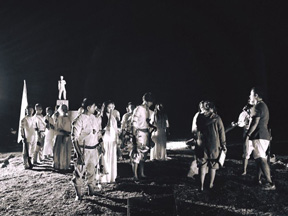The Ashes and Ghosts of Tayug 1931
Dapol Tan Payawar Na Tayug 1931 THE PHILIPPINES / 2017 / Pangasinan, Iloko / B&W / DCP / 115 min
THE PHILIPPINES / 2017 / Pangasinan, Iloko / B&W / DCP / 115 min
Director, Script: Christopher Gozum
Narration, Producer: Fe Hyde
Photography: Chino De Vera
Editing: Carla Ocampo, Epoy Deyto
Sound: Willie Apa, Jr.
Music: Ran Kirlian, Darren Vega
World Sales: Sine Caboloan
www.sinecaboloan.wordpress.com
Tayug, a town located in Pangasinan province on the island of Luzon—here in 1931, the young Filipino revolutionary Pedro Calosa led a failed agrarian uprising to combat the exploitation suffered by tenant farmers. As a filmmaker visits the area to track down what faint trace may still remain of Calosa, a young man returning to his country from Hawaii to grow into a leader and an old man grieving the world in his final years both manifest on the screen like afterimages. Silent film, fiction, documentary—different eras and different film languages intertwine in the work as the apparition of a forgotten hero is woven across its black-and-white images.
[Director’s Statement] The subject of the film has remained an unhealed wound in Tayug, Pangasinan Province and in the rest of the country for the past 85 years. In the 1930s, when it occurred, the uprising was dismissed and condemned by the authorities. The cause of the rebellion was not addressed by the government at that time. The Tayug rebels were cruelly punished and dismissed as religious fanatics.
Today, the people of Tayug walk on a ground littered with the ashes of a town the PNA (Philippine National Association) rebels burnt down in 1931. The ghosts of those who died continue to haunt them. Sadly, they have no memory of the event, or they choose to forget.
Although branded as criminals by the authorities in the thirties, Calosa and the Tayug rebels’ important contribution to Filipino history were reassessed by a young generation of writers and historians, beginning in the sixties. They saw the Tayug rebellion as a crucial part of a Filipino revolutionary tradition linked to other popular movements in the country, like Bonifacio’s Katipunan revolt, the Palaris revolt, and the Dagohoy revolt.
This film does not aim for a resolution, but to create an awareness of these unresolved issues.
Art educator and filmmaker who is also actively involved in various local art and culture projects and initiatives in his hometown of Bayambang, Pangasinan. Gozum studied at the University of the Philippines and the 2006 Asian Film Academy (Korea). His films received the Cultural Center of the Philippines Award for Alternative Film and Video (2005), as well as the Best Short Film (2007), the Ishmael Bernal Award for Young Filipino Filmmaker (2008), the Lino Brocka Grand Prize (2009) and the Best Director Award (2009), all in the Digital Lokal section of the Cinemanila International Film Festival. Anacbanua (The Child of the Sun), an experimental film about Pangasinan’s history, art, and culture which he produced, directed, and edited, is the first feature film in the Pangasinan language. It received the Prix des Signes in the Cinema in the Transgression section of the 10th International Festival Signes de Nuit. His second feature film, Lawas Kan Pinabli (Forever Loved), a hybrid documentary about overseas Filipinos in the Middle East, was released in 2012. The Ashes and Ghosts of Tayug 1931 received the 5th Quezon City International Film Festival Circle Competition NETPAC Jury Prize, had its international premiere in the 47th International Film Festival Rotterdam, and received Best Screenplay award in the 41st Gawad Urian. He has participated in the Southeast Asian Film Lab and Berlinale Talents, and has received the Seoul Film Commission’s Screenplay Development Support for a new Pangasinan feature film in development called Ilikdem Mo So Matam (Close Your Eyes).
